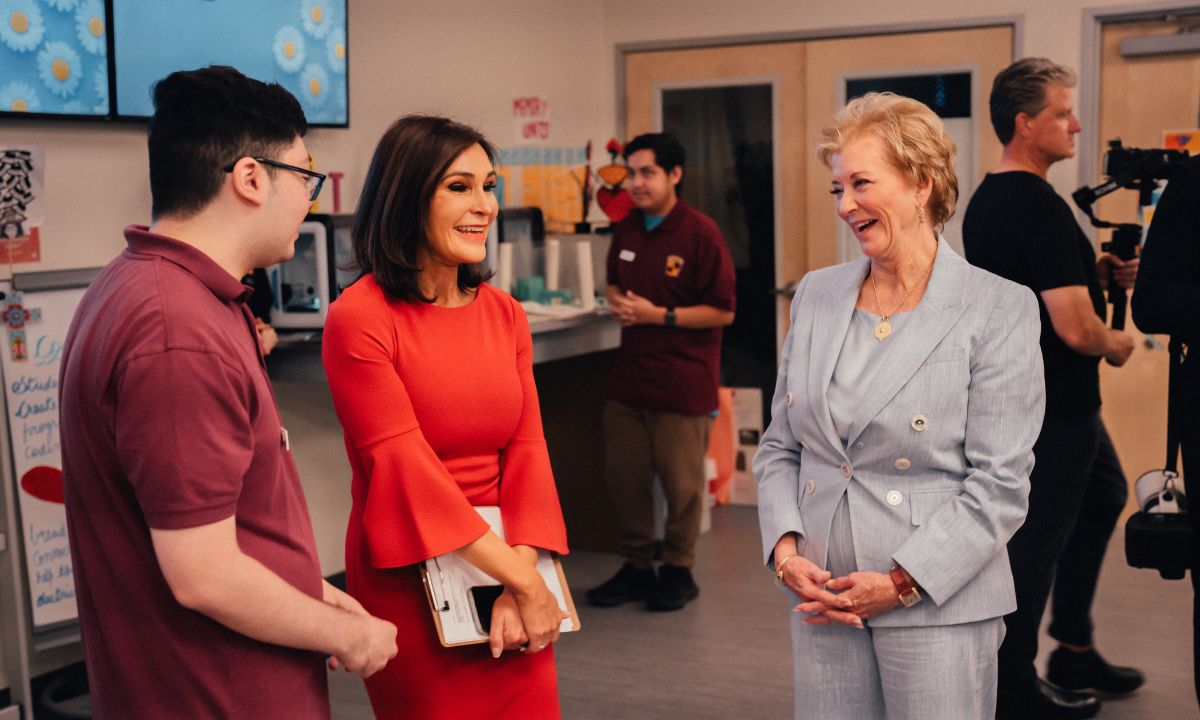Trump Official’s Autism Schools Secluded and Restrained Students at High Rates
Diana Diaz-Harrison's Arizona Autism Charter Schools restrained 41% of kids and put 20% in seclusion in 2020-21, 50% higher than the national average.

Get stories like this delivered straight to your inbox. Sign up for The 74 Newsletter
Updated on May 15, 2025
Arizona Autism Charter Schools, whose founder Diana Diaz-Harrison has been tapped to oversee the education of children with disabilities in President Donald Trump’s second administration, has used controversial, potentially dangerous disciplinary practices on its students at an unusually high rate.
In the 2020-21 academic year, the latest for which federal data is available, school staff physically restrained 41% of its students and put 20% in seclusion, which is defined by the U.S. Department of Education as the involuntary confinement of a child, typically in a locked room. That’s 50% higher than the rate at which students are restrained and confined nationally.
For 35 years, the U.S. Government Accountability Office and disability advocates have documented hundreds of cases in which students as young as 4 were injured, traumatized or even killed while being isolated or held down — often in response to nonviolent behavior. In states that ban the practices, educators typically are allowed to intervene if there is imminent danger of serious physical injury to the student or to others.
Many states — including Arizona — have outlawed or severely curtailed the circumstances under which the practices are allowed. In 2017, federal education officials warned that yawning disparities in restraint and seclusion likely constitute discrimination. Eighty percent of U.S. students who are physically restrained have disabilities, as do 77% of those secluded.
In 2019, then-Education Secretary Betsy DeVos launched an initiative to address inappropriate restraint and seclusion in U.S. schools. In January 2025, her outgoing successor, Miguel Cardona, called on states and school districts to end the practices entirely.
At the time the data was collected, the charter network founded by Diaz-Harrison had two schools serving 283 students, 116 of whom were restrained and 57 secluded. Ninety-nine of the schools’ 146 K-5 students, or 68%, had been restrained.
Located in the same area served by the Arizona Autism Charter Schools, the 27,000-student Phoenix Union High School District restrained three students in 2020-21 and secluded none. The nearby Mesa Unified District, with more than 50,000 students, restrained 93 and secluded 67.
In August 2020, in the midst of the COVID pandemic, Arizona ordered schools to reopen for students who had no other safe place to spend the day and to prioritize serving children with disabilities, many of whom had missed months of crucial special education services. Schools fully reopened to in-person schooling on March 15, 2021.
Of Arizona’s 1 million K-12 students, 675 were restrained in 2020-21, as were 28,000 of 49 million children nationally.
Ron Harrison, the interim CEO of Arizona Autism Charter Schools, noted that unlike most other schools, the student population of Arizona Autism Charter is comprised almost entirely of children who have autism or learning differences.
“Our intervention rates may be higher than traditional schools because of the distinct student population we serve and our practice to err on the side of reporting every applicable incident, regardless of how minor,” wrote Harrison in a statement. “By comparison, underreporting of similar interventions is rampant nationally – especially among large school districts – and has been the subject of federal scrutiny.”
Harrison added that independently tracked parent satisfaction scores at Arizona Autism Charter schools “have never fallen below 92%” and most recently were higher than 97%.
Diaz-Harrison, who has taken a leave from Arizona Autism Charter to focus on her new federal role, did not respond to requests for comment.
Since 2020-21, Arizona Autism Charter Schools has grown to five schools enrolling nearly 1,000 students. The schools use a controversial intervention called applied behavior analysis, or ABA, that is opposed by many autistic adults as coercive and traumatizing. Created by the researcher behind LGBTQ conversion therapy, ABA attempts to train children to appear and behave like their neurotypical peers. It is widely depicted as the gold standard despite scant independent evidence of its effectiveness and mounting research documenting its harms.
For a story announcing her appointment as the U.S. Education Department’s deputy assistant secretary for special education and rehabilitative services, Diaz-Harrsion provided a statement to The 74 applauding the approach. “For the autism community, specifically, many families seek schools that integrate positive behavioral strategies,” she said. “The evidence supporting behavioral therapy is extensive and well-established. It has been endorsed by the U.S. surgeon general and the American Academy of Pediatrics as an effective, research-backed approach for individuals with autism.”
In 2010, the Association for Behavior Analysis International issued a statement opposing “inappropriate” restraint and seclusion but supporting the interventions when used by ABA practitioners as part of a formal plan.
“When used in the context of a behavior intervention plan, restraint in some cases serves both a protective and a therapeutic function,” the organization wrote. “These procedures can reduce risks of injury and can facilitate learning opportunities that support appropriate behavior.”
There is no evidence that restraint and seclusion have a positive effect on student behavior. Indeed, if the discipline is traumatizing, a child can manifest new behaviors, according to guidance from federal education officials.
“All of our teachers and staff members who interact with students are specially trained,” Harrison said. “When a behavioral intervention is required to ensure the safety of students or staff members, we follow strict protocols which are never punitive and always designed to de-escalate the situation.”
Federal education officials have repeatedly urged school systems to train staff on de-escalation and to institute protocols for addressing inappropriate behavior without resorting to punitive measures. When a student with a disability is restrained or secluded, U.S. officials warn, it could mean that their special education plan may be insufficient or not providing the right services.
Editor’s Note: This story was updated on May 15, 2025 to include statements from Ron Harrison, the interim CEO of Arizona Autism Charter Schools.
Get stories like these delivered straight to your inbox. Sign up for The 74 Newsletter

;)
